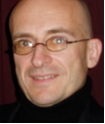
Daniel Mellet d'Huart
Centre Européen de Réalité Virtuelle (CERV)
MELLET-d'HUART D. De l'intention à l'attention. Contributions à une démarche de conception d'environnements virtuels pour apprendre à partir d'un modèle de l'(én)action . Thèse de Doctorat de l'Université du Maine. Spécialité : Informatique. 2004.
http://www.dm-dh.com/FichiersPdf/2004_TheseDanielMellet-dHuart_Lium-UnivDuMaine_1.pdf
MELLET-d'HUART D. A Model of (En)Action to approach Embodiment: A Cornerstone for the Design of Virtual Environments for Learning. In WIN W. & HEDLEY N., Eds. Journal of Virtual reality, special issue on education. Springer London. Volume 10, Numbers 3-4 / December, 2006. Pp. 253-269. 2006, http://www.springerlink.com/content/8222p74238524560/
Abstract This paper presents a model of (en)action from a conceptual and theoretical point of view. This model is used to provide solid bases to overcome the complexity of designing virtual environments for learning (VEL). It provides a common grounding for trans-disciplinary collaborations where embodiment can be perceived as the cornerstone of the project. Where virtual environments are concerned, both computer scientists and educationalists have to deal with the learner/user's body; therefore the model provides tools with which to approach both human actions and learning processes within a threefold model. It is mainly based on neuroscientific research, including enaction and the neurophysiology of action.
Keywords Virtual environment for learning - Virtual reality - Learning - Design method - Model of action
Research theme
Engineering methods to design virtual environments for learning based on a meta-model of human action in an enactive paradigm.
The use of virtual reality for learning (training & education)
Video and experimental material
" La réalité virtuelle pour former : Virtuel mais tellement réel " Une série de 4 émissions de télévision de 26' - Production AFPA-TFS et Point du Jour, réalisateur Axel NILSSON - Diffusion chaîne DEMAIN, 2002 - En ligne sur : http://tfs.afpa.fr/
http://tfs.afpa.fr/site2/index.asp?rubr=131&idserie=38
- Réalité virtuelle n° 01 - De la réalité en plus ?
- Réalité virtuelle n° 02 - Au delà de la magie
- Réalité virtuelle n° 03 - Former autrement
- Réalité virtuelle n° 04 - A vous de jouer !
Ainsi que 2 plateaux de 52' :
- "Réalité virtuelle, simulation et e-learning : l'apport des neurosciences"
- "La réalité virtuelle en formation: qu'est-ce que cela change ? "
2006, Production AFPA-TFS et Savoirs Interactifs, Diffusion chaîne DEMAIN, 2006.